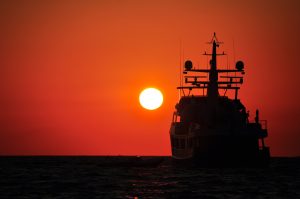Fires on seagoing vessels cause great damage, people can be injured and often ships have been abandoned as a result. Fire protection equipment and facilities must be able to withstand the conditions of the sea. For this purpose, testing standards are developed partly by the IMO, but also by international standardization organizations.
Compliance with the international requirements is officially monitored by the Federal Maritime Office (BSH) and the Berufsgenossenschaft Verkehr, Dienststelle Schiffssicherheit. The national introduction of the binding, international fire protection regulations is carried out by the Ship Safety Act.
The international shipping organisation IMO has developed fire safety regulations for international merchant vessels under the International Convention for the Protection of Life at Sea (SOLAS).

In July 1998, IMO introduced the FTP Code. It contains a compilation of fire testing methods for fire protection of components and materials used on ships.
The FTP Code uses fire tests developed by the International Standards Organization (ISO) that address the areas of non-combustibility, fire resistance, fire behavior, flame propagation, smoke and toxicity of components and materials, as well as special products such as textiles, upholstered furniture and beds.
The required tests are listed under these so-called ‘Fire Test Procedure Codes’:
We have listed the respective fire test procedures with the help of the test laboratory for fire protection DMT GmbH & Co. KG, briefly listed for you.
IMO FTPC Part 1: Non-combustibility testing – ISO 1182:2020
The test procedures are similar to those in ISO 1182, where five samples are tested in a tube furnace and subjected to a temperature of 750 °C for 30 minutes. Control measurements for moisture content, organic content and density are also required.
IMO FTPC Part 2: Surface materials tests for smoke density and toxicity. (Bulkheads, linings or ceilings, floor coverings. )
The test procedure is similar to ISO 5659-2 for three heat exposure conditions on at least three specimens for each test condition. Toxicity is also measured with requirements for maximum concentrations for several substances, including carbon monoxide, hydrogen chloride, hydrogen fluoride, nitrous oxide, hydrogen bromide, hydrogen cyanide, and sulfur dioxide.
IMO FTPC Part 3: Testing of “A”, “B” and “F” class divisions.
The test applies a variety of products: Building insulation, deck assemblies, continuous ceilings, bulkhead panels, windows, fire doors, cable penetrations, conduit penetrations, duct penetrations, and dampers. Acceptable levels and test criteria vary by product type and class classification. This is a fire resistance test with integrity and insulation requirements.
IMO FTPC Part 4: Fire Testing of Control Systems (Fire Doors).
The door is tested for 60 minutes in an oven at 200 °C during operation (opening and closing). The test is then continued with increasing temperatures to 945°C according to the standard ISO time-temperature curve.
IMO FTPC Part 5: Flammability of Surfaces Test (test for surface and ship deck materials, for bulkheads, walls and ceilings; floor coverings; primary deck coverings; insulation for cold water systems; and adhesives used for Class “A”, “B” and “F” subdivisions).
At least three samples are evaluated for critical flow during extinguishment (flame spread), heat for sustained burning, total heat release, maximum heat release rate, and in some cases, burning droplets produced. Click here for PDF.
IMO FTPC Part 6: Fire test for primary deck coverings. Has been included in part 5!
IMO FTPC Part 7: Testing of vertical textiles (e.g. curtains) and films.
It contains freely selectable pre-test exposure conditions for non-inherent “flame resistant” materials. Tests must be performed in warp and weft directions and include surface ignition tests, edge ignition tests, and flame droplets. Failure points are included for afterburn time, edge burn-through, wad ignition, average char, and surface flash.
IMO FTPC Part 8: Testing of Upholstered Furniture and
IMO FTPC Part 9: Testing of bedding (blankets, pillows, quilts, bedspreads, mattresses).
Smoldering cigarette and propane flame tests. For both parts, no progressive smoldering or flame ignition shall occur.
IMO FTPC Part 10: Testing of fire resistant materials for high speed ships (fire retardant materials, in particular surface materials on bulkheads, wall and ceiling linings, and materials used for furniture and other components, and
IMO FTPC Part 11: Testing of fire-resistant areas for high-speed ships.
Both parts contain criteria for fire resistant properties. as well as criteria for insulation and integrity.
Annex 2 Products that may be installed without testing and/or approval;
Annex 3 Fire protection materials and required approval test methods;
Annex 4 SOLAS, Chapter II-2, Regulation 5.3 and 6.2, (MSC/Cir.1120).
